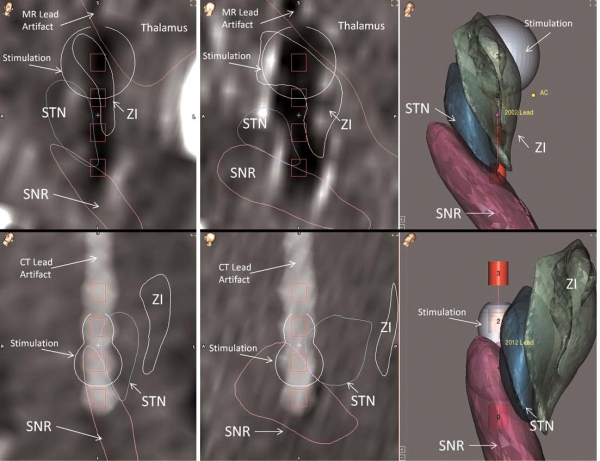Session Information
Date: Monday, June 20, 2016
Session Title: Surgical therapy: Parkinson's disease
Session Time: 12:30pm-2:00pm
Location: Exhibit Hall located in Hall B, Level 2
Objective: A variety of technical considerations influence the outcome of Deep Brain Stimulation (DBS). We highlight a case where revising the angle of approach significantly impacted the outcome. We further investigated the neuroanatomical basis of the pre-revision side effects using computer-based modeling of regions being stimulated.
Background: Targeting the subthalamic nucleus (STN) for DBS generally results in effective symptomatic relief for the cardinal motor features of Parkinson’s disease (PD). The angle of approach, however, influences the resultant field of stimulation and can lead to undesired side effects.
Methods: We review a case where improvement of tremors and dyskinesias was accompanied by latent and severe dysarthria and dystonia despite reasonable stereotactic base coordinates. Revision of the lead using similar base coordinates but a 20 degree different angle of approach greatly improved the outcome. Coordinates for the centers of each contact pre- and post-revision were calculated from postoperative MR and CT images (table 1)
| pre revision | post revision | |
| x, y, z of zero contact | 10.2 x 4.1 x 5.3 | 11.6 x 3.4 x 5.3 |
| DBS Settings | C+3- 3.0/60/145 | 2+1- 1.3/60/145 |
| Off/Off mUPDRS | N/A (2008) | 56 (2012) |
| Off med/ON stim mUPDRS | 29 (2008) | 33 (2012) |
| Active contact coordinate (x, y, z) | 11.8 x -0.4 x 3.3 | 13.3 x -1.8 x -3.1 |
Results: Stimulation ventromedial to the STN and involving the region of the zona incerta improved tremors but brought about dysarthria and dystonia. The post-revision parameters appear to involve more of the dorsolateral STN with some spread to the substantia nigra [Figure 1A and B, bottom panels] . Whereas the pre- versus post-revision coordinates of the centers of the bottom contacts are separated in 3D space by only 1.6 mm, the pre- versus post revision active contacts (contact 3 on the old lead, contact 1 on the new lead) are separated by approximately 6.7 mm with no overlap in modeled fields of stimulation (Figure 1C).
. Whereas the pre- versus post-revision coordinates of the centers of the bottom contacts are separated in 3D space by only 1.6 mm, the pre- versus post revision active contacts (contact 3 on the old lead, contact 1 on the new lead) are separated by approximately 6.7 mm with no overlap in modeled fields of stimulation (Figure 1C).
Conclusions: Despite similar base contact coordinates, outcome differed significantly following change in angle of approach. Computer-based stimulation field modeling helped clarify the regions associated with the side effects and illustrate the difference between pre- and post-revision stimulation fields. Lead angle can impact DBS outcome and should be taken into consideration, particularly when revising a lead associated with a narrow therapeutic window.
To cite this abstract in AMA style:
M.H. Pourfar, A.Y. Mogilner. Lead angle matters: Side effects of deep brain stimulation improved with adjustment of lead angle [abstract]. Mov Disord. 2016; 31 (suppl 2). https://www.mdsabstracts.org/abstract/lead-angle-matters-side-effects-of-deep-brain-stimulation-improved-with-adjustment-of-lead-angle/. Accessed January 7, 2026.« Back to 2016 International Congress
MDS Abstracts - https://www.mdsabstracts.org/abstract/lead-angle-matters-side-effects-of-deep-brain-stimulation-improved-with-adjustment-of-lead-angle/
